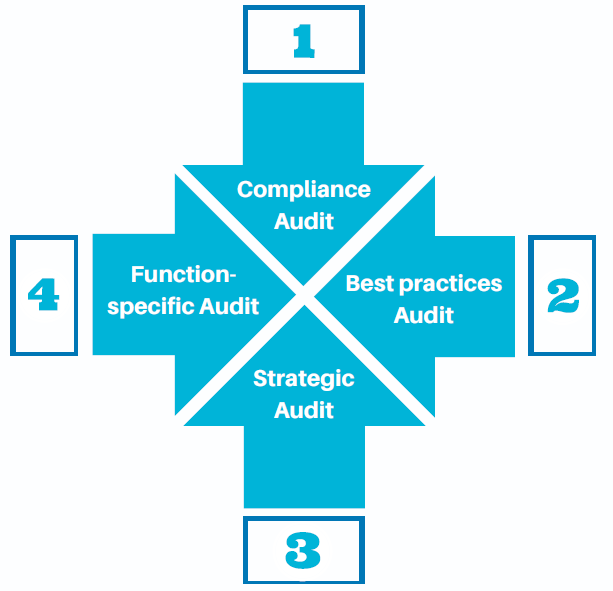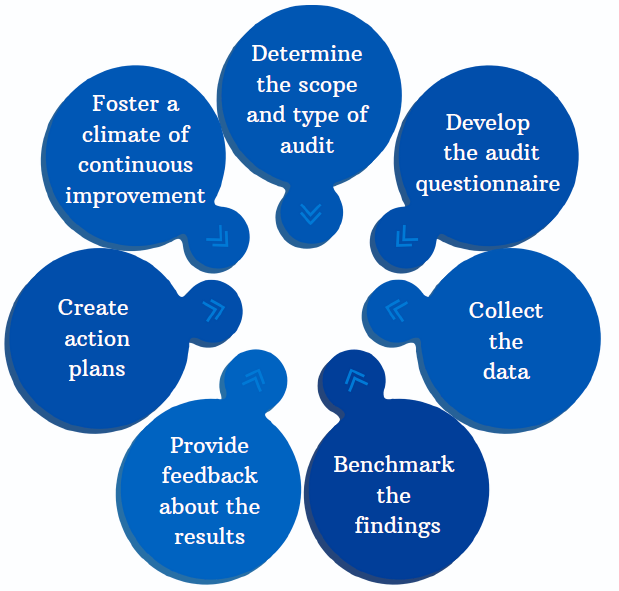Human Resource Audit
Human Resource Audits identifies the effectiveness and adequacy of the HR department specific practice areas or processes. The results obtained from this audit prioritize these gaps in an effort to minimize lawsuits or regulatory violations. It will also help in achieving and maintaining world-class competitiveness in the HR practice areas. The Human Resource Audit also involves identifying the issues and finding solutions to problems before it becomes unmanageable. It provides an opportunity to assess what the organization is doing right and how things can be done differently, in a more efficient manner and at a reduced cost.
In the current competitive climate, organizations operate within the limits of a heavily regulated employee environment. The given challenge includes dealing with various complex laws and regulations. The HR function's scope includes establishing and administering a host of policies and practices, many of which involve compliance implications. It significantly influences the productivity and profitability of the organization.
A Human Resource Audit process will provide many advantages to the organization, such as linking the HR strategy, re-engineering the systems and procedures, and improving the HR systems' competency and functional efficiency.
What is Human Resource Audit?
A Human Resource Audit (or HR Audit) is a complete comprehensive method to review the current human resources policies, documentation, procedures, and systems. This overall review helps in identifying the needs for improvement and enhancement of the HR function. Further, it also helps to assess compliance with the ever-changing rules and regulations. An Audit involves a systematic review of all aspects of human resources, usually in a checklist fashion.
A Human Resource audit involves dedicating time and resources to take an intensely objective look at the organization's HR policies, practices, procedures, and strategies. It also helps in protecting the organization to establish best practices and check the opportunities for improvement.
A Human Resource Audit Compliance usually consists of two parts:
- Evaluating the organization's operational HR policies, processes, and practices. It can be done by focusing on the vital HR department delivery areas such as recruiting both internal and external compensation, employee retention, employee benefits, performance management, training, and development, etc.
- A complete review of the current HR indicators. For example number of unfilled positions, turnover, employee satisfaction, internal grievances, number of legal complaints etc.
HR generally conducts an audit by preparing a questionnaire that asks for the evaluation of specific practice areas. This document helps guide the audit team in investigating all the crucial areas of an organization's HR practices. The audit also includes interviewing or using questionnaires to receive feedback from the selected HR employees to check whether the specific procedures and policies are practiced, understood, and accepted.
What are the Objectives of Human Resource Audit?
The objectives of Human Resource Audit are as follows:
- To determine the effectiveness of each program in the organization and also to review every aspect of the management of HR.
- To gather all the information and explanation with respect to the success and failure of HR.
- To follow the implementation of policies.
- For evaluating the performance of personnel staff and employees.
- To know about the values, priorities, and goals of the management philosophy.
What are the Types of Human Resource Audit?
The Human Resource Audit can be structured in either a comprehensive way within budget constraints, time, and staff. There are many types of audits, and it is designed to accomplish different objectives.
Some of the common types of Human Resource Audits are:

Compliance Audit usually focuses on how properly the organization complies with the central laws, local laws, and regulations.
This type of audit helps the entities maintain or improve the competitive advantage by comparing their practices with good HR practices.
The strategic audit focuses on the strengths and weaknesses of the systems and processes for determining whether they support the HR departments and the organization's strategic plan.
The function-specific audit focuses on specific HR function areas, such as payroll, performance management, etc.
What is the Process for Human Resource Audit?
The general process of conducting a Human Resource Audit is as follows:

-
Determine the scope and type of audit
To uncover the required information, the audit team needs to determine the exact target areas to target for review. In case the entity has never audited its HR function or occurrence of any significant organizational or legal changes, the audit team would like to conduct a comprehensive review of all the HR practice areas. In addition, if the concerns are limited to the adequacy of a specific process or policy, the audit team will be able to focus its review on that particular area.
-
Develop the audit questionnaire
While conducting a comprehensive audit or an audit of specific practice, the audit team must invest sufficient time in developing a document that provides information on all the subjects of the inquiry. HR should develop a list of certain questions to ensure that the questionnaire is complete.
The next stage incorporates the actual procedure of reviewing specific regions to gather information about the entity and its HR practices. The audit team members will utilize the review poll as a guide to survey the particular territories distinguished inside the extent of the audit.
To thoroughly survey the audit findings, the team must compare them with the set HR benchmarks. This correlation will offer knowledge into how the review results think about other comparably measured firms, national guidelines, or authoritative interior information. Average data that may be inside benchmarked incorporates the association's proportion of all-out workers to HR experts, the percentage of dollars spent on HR work comparative with absolute deals, general and regulatory expenses, and cost per new employee hired.
National standard benchmarking may incorporate the number of days to fill a position, the average expense of yearly employee benefits, and non-attendance rates.
-
Provide feedback about the results
At the end of the audit process, the audit team must summarize the information and give input to the entity's HR experts and senior management as discoveries and proposals. Discoveries are ordinarily decreased to a written report with suggestions organized dependent on the hazard level appointed to everything (e.g., high, medium, and low). From this last examination, the audit team can build up a course of events for the activity that will help decide the request wherein to address the issues raised. Notwithstanding a conventional report, the audit team ought to talk about the consequences of the review with workers in the HR office, just as with the senior management, so everybody knows about fundamental changes and that approvals can be obtained quickly.
It is essential that the organization really accomplish something with the data distinguished because of the audit. The organization must make activity plans for executing the progressions recommended by the review, with the discoveries separated by request of significance: high, medium, and low. Directing a review and afterward neglecting to follow up on the outcomes really increments legal risk.
-
Foster a climate of continuous improvement
At the finish of the review, HR pioneers must take part in consistent perception and persistent improvement of the association's approaches, techniques, and practices with the goal that the organization never stops to continue improving. This will guarantee that the organization accomplishes and holds its upper hand. One approach to do this is to persistently screen HR frameworks to ensure that they are cutting-edge and to have follow-up systems incorporated with all of them.
One methodology is to assign somebody on staff (or an outside advisor) to screen lawful improvements to guarantee that HR approaches and practices are kept current. In like manner, associations should monitor the review discoveries and changes made, turnover, grievances recorded, hotline issues, and worker overview results to recognize patterns in the association's business-related matters. Understanding serious issues, development zones, or declining issue spots can help in choosing where to allot time, cash, and preventive preparing assets later on.
What are the Approaches to Human Resource Audit?
The approaches that can be adopted by an auditor for evaluating the performance of the HR department are as follows:
In this approach, the auditor identifies any company, generally the competitor's company, as a model. Then the results obtained by the organization are compared with that of the model company.
-
Outside Authority Approach
The auditor generally uses the standard set as a benchmark by the outside consultant and then compares its organization performance with that of the other organization.
Under this approach, the auditor develops some statistical measures of performance for the organization's current information, such as turnover rates and absenteeism.
Here, the auditor checks the company's previous actions to ensure that those activities comply with the legal requirements and is in line with the company's procedures and policies.
-
Management by Objective Approach
The auditors, as per this approach, check the performance of the HR personnel against the goals set by the senior management.
It is suggested to conduct a Human Resource Audit once every year so that the HR department's performance with regard to its selection process and recruitment, grading system, compensation plan, layoff schemes, and other HR functions can be checked. By doing this, it is ensured that the human resource practices are carried out at its best and is reducing the organization's liability ultimately.
What is involved in Human Resource Audit?
Auditing engages an organized and structured review of the organizational practices. By reviewing the company and its department goals, procedures, policies, legal requirements, and established processes, the Human Resource Audit provides a complete review to assure that the company is on track and compliant. The review will also help in identifying the gaps in policies and what is happening compared to what should be happening. Many audits identify areas where the specified procedures are not followed or have not been updated. Identifying outdated or inconsistent policies and procedures can lead to:
- Review of processes for determining what makes the most sense for your organization.
- Ensuring that everyone is following the same specified procedures.
- Process improvement and enhanced customer service.
- Assuring legal compliance.
- Improvement of the quality of the process from those inside human resources and that outside of the process relies on it for their department's success.
How can TAP GLOBAL Help You?

Fill The Form

Get a Callback

Submit Document

Track Progress

Get Deliverables